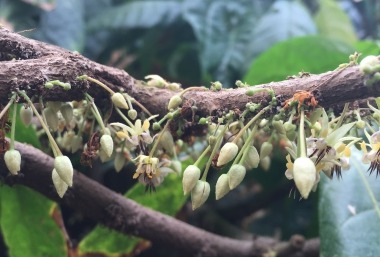Four themed botanical environments – water, air, sunlight, and sugar – help visitors discover how right now, inside every leaf, plants are capturing sunlight and using it to change small parts of air and water into sugar – the energy that sustains life on Earth. This is the story of photosynthesis, the process whereby plants use sunlight energy to change water and carbon dioxide from the air into sugar, or fuel, for their own survival as well as the survival of all other living things. Since plants are the only living things that can photosynthesize, all living things depend on their ability to make their own food and pass that energy along the food chain.
Vanilla Orchid

Look closely at the vines to spot the long green vanilla pods. This is the only orchid with edible fruit and typically requires a labor-intensive process to produce the versatile baking spice we know and love.
The vanilla orchid is native to Southeastern Mexico and is the only place in the world where the Melipona bee pollinates the flowers. In places other than Mexico each flower must be hand-pollinated in the early morning to produce a vanilla pod ”bean”. Each flower remains open for just 12 hours, after which, if not pollinated, it wilts, dies, and drops to the ground.
Once pollinated, the pod forms. This pod remains on the vine for 8-12 months and turns brown when ripe. The pod must then be dried for 5-8 months before it can be used. Because vanilla production is so labor intensive, the majority of vanilla used today is synthetic.
Epiphytes

As you walk through the air section of this room stop for a moment and look up. You’ll notice several plants hanging off of and sitting upon a metal frame. These plants are called epiphytes, or more commonly, air plants. Epiphytes are plants that grow on other plants, such as tall trees. These plants are also unique because they do so without harming the other plant. They rely on the host plant for structural support, but can otherwise get all of their water and minerals through the air.
Chocolate Tree

Do you know where chocolate comes from? The chocolate we consume comes from the seeds of this tropical plant. Once picked, the fruit of the chocolate tree is cut open, exposing a somewhat mucus-like fruit with 20-40 seeds. The seeds are then put between two banana leaves and left to ferment for 3-5 days. Following fermentation they are dried in the sun and then shipped to factories for further processing, including roasting. Interestingly, the cacao fruit tastes nothing like the chocolate we all know and love. In fact, the seeds don’t take on this flavor until half way through the processing when they are roasted.


